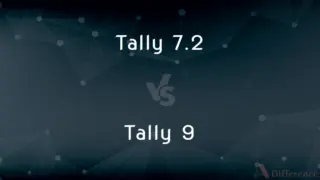Deadlock In Os vs. Starvation In Os — What's the Difference?
By Tayyaba Rehman — Published on December 8, 2023
In OS, deadlock refers to a situation where processes are stuck, waiting for resources that are held by others, while starvation occurs when processes are indefinitely delayed due to continual resource preemption.

Difference Between Deadlock In Os and Starvation In Os
Table of Contents
ADVERTISEMENT
Key Differences
Deadlock in an operating system (OS) is a state where multiple processes are unable to proceed because each one is waiting for the other to release a resource. This mutual waiting creates a situation where neither process can continue its execution. Starvation in OS, on the other hand, arises when a process is continually denied the necessary resources to progress because other processes are always favored.
When thinking about Deadlock in OS, one can envision two people standing in a narrow hallway, each waiting for the other to move first. This results in neither person moving forward, similar to how processes in deadlock wait for resources. In contrast, Starvation in OS can be visualized as a line at a food counter where one person never gets to the front because others are always given priority.
The causes for Deadlock in OS revolve around mutual exclusion, hold and wait, no preemption, and circular wait conditions. All these conditions collectively contribute to the deadlock phenomenon. Starvation in OS is typically due to scheduling policies or algorithms that inadvertently neglect or de-prioritize certain processes over an extended period.
To handle Deadlock in OS, systems may employ detection algorithms, prevention schemes, or sometimes even allow the deadlock and then intervene. With Starvation in OS, the remedy usually involves altering scheduling policies or implementing aging techniques, where waiting processes gradually increase in priority over time.
While both Deadlock and Starvation in OS are undesirable scenarios that can severely impact system performance and responsiveness, they are fundamentally different. Deadlock represents complete process stagnation due to mutual resource dependence, while Starvation signifies unequal resource allocation leading to prolonged delays for some processes.
ADVERTISEMENT
Comparison Chart
Definition
Processes stuck due to mutual resource dependence
Processes indefinitely delayed due to resource preemption
Visualization
Two people in a hallway, neither can move
A person never reaching the front of a line
Causes
Mutual exclusion, hold and wait, no preemption, circular wait
Scheduling policies favoring certain processes
Remedy
Detection, prevention, or intervention
Altering scheduling or implementing aging
Impact on Performance
Processes cannot proceed
Prolonged delays for certain processes
Compare with Definitions
Deadlock In Os
Arises due to conditions like mutual exclusion and circular wait.
By studying system behaviors, one can identify the onset of Deadlock in OS.
Starvation In Os
A situation where a process faces indefinite delays.
Due to flawed scheduling, one application faced Starvation in OS.
Deadlock In Os
Mutual waiting of processes for resource release.
Deadlock in OS occurred because each application awaited the other's resource release.
Starvation In Os
Represents prolonged waiting, not complete system halt.
Even with other tasks running smoothly, one can encounter Starvation in OS.
Deadlock In Os
A scenario needing intervention or prevention mechanisms.
Advanced OS designs have built-in tools to address Deadlock in OS.
Starvation In Os
Occurs when processes are denied necessary resources.
Starvation in OS is evident when tasks are continually postponed.
Deadlock In Os
An undesirable condition causing complete system stagnation.
Efficient systems aim to prevent Deadlock in OS to maintain responsiveness.
Starvation In Os
A consequence of imbalanced resource allocation policies.
Inefficient task management can lead to Starvation in OS.
Deadlock In Os
A state where processes can't progress due to resource conflicts.
The system experienced a Deadlock in OS when two apps vied for the same memory segment.
Starvation In Os
Typically addressed by modifying scheduling or using aging.
To combat Starvation in OS, developers adjusted the system's task prioritization.
Common Curiosities
How is Starvation in OS different from Deadlock?
Starvation involves prolonged delays for processes, while Deadlock results in complete process stagnation.
Is Deadlock in OS a permanent state?
Without intervention, processes in deadlock remain stuck indefinitely.
Is Deadlock in OS a resource management issue?
Yes, it arises from conflicting resource requests among processes.
Does Starvation in OS halt the entire system?
No, only specific processes face prolonged delays, but the system continues running.
Can Starvation in OS affect user experience?
Yes, as affected applications may become unresponsive or slow.
How can Deadlock in OS be resolved once detected?
By forcibly terminating or rolling back processes, or manually releasing resources.
Can Deadlock in OS be prevented?
Yes, by avoiding the necessary conditions or using prevention algorithms.
Is Starvation in OS related to task priority?
Often, as lower-priority tasks might get indefinitely delayed due to higher-priority ones.
How can Starvation in OS be mitigated?
By altering scheduling policies or using aging techniques.
What causes Deadlock in OS?
Deadlock is caused by mutual exclusion, hold and wait, no preemption, and circular wait.
Why does Starvation in OS occur?
Due to imbalanced or unfair resource allocation and scheduling.
Are Deadlocks common in modern operating systems?
Modern OS designs incorporate mechanisms to reduce the likelihood of Deadlocks.
Can Deadlock in OS be detected?
Yes, using specific detection algorithms.
Share Your Discovery

Previous Comparison
Tally 7.2 vs. Tally 9
Next Comparison
Italians vs. EuropeansAuthor Spotlight
Written by
Tayyaba RehmanTayyaba Rehman is a distinguished writer, currently serving as a primary contributor to askdifference.com. As a researcher in semantics and etymology, Tayyaba's passion for the complexity of languages and their distinctions has found a perfect home on the platform. Tayyaba delves into the intricacies of language, distinguishing between commonly confused words and phrases, thereby providing clarity for readers worldwide.














































